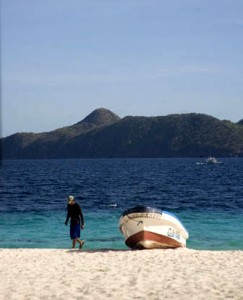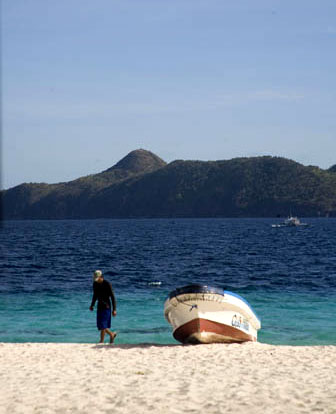
In September 1944, as the story goes, Admiral “Bull” Halsey sent out reconnaissance planes to map out a route to the northwest. When pilots discovered a Japanese fleet at Coron Bay, attacks were ordered and many of the ships were sunk. Nine have been discovered, however, the U.S. Navy’s records indicate several more were destroyed and await discovery.
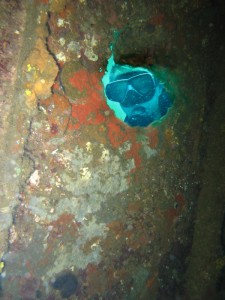 We dived the Kyokuzan Maru, dubbed the Dimalanta Wreck, located at the north east end of Busuanga, a 450-foot Japanese Cargo Ship – possibly an army auxiliary supply ship – sunk on September 24, 1944. Her mast starts at about 40 feet, and the wheelhouse is at 70 feet. Her deck level is at 90 feet and her hull sinks into the sand at 140. We’re told it takes five dives to see the entire wreck.
We dived the Kyokuzan Maru, dubbed the Dimalanta Wreck, located at the north east end of Busuanga, a 450-foot Japanese Cargo Ship – possibly an army auxiliary supply ship – sunk on September 24, 1944. Her mast starts at about 40 feet, and the wheelhouse is at 70 feet. Her deck level is at 90 feet and her hull sinks into the sand at 140. We’re told it takes five dives to see the entire wreck.
Nose-diving down, I was disappointed that the visibility was so poor. Apparently, during the cooler climes of the rainy season, visibility improves, whereas, the hot, sunny, dry season creates a plankton bloom, which reduces the visibility to a few feet.
Still, at 90 feet I was happy swimming across great slabs of metal coated thick with coral and sponges. There were fish around – when I could see them. I dipped down into one of the holds and could just make out a vehicle (had I not been told a car and truck are within I’d have never been able to identify what I saw). I swam in and around the wheelhouse, looking through portholes, losing and then finding my dive buddy again. Whether underwater or topside, I’ll always be fascinated by manmade structures, no matter what their form.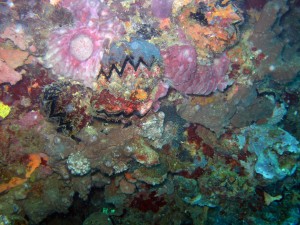
Sinking into the SeaRolf Winkelhausen, PADI Master Scuba Diver Trainer, and Dirk Fahrenbach, PADI Master Instructor, schedule trips on their liveaboard boat to visit other wrecks. Among them are the Black Island Wreck, a coastal vessel about 120 feet long, which ran aground on the reef and sank, and the Olympia Maru, a 450-foot Japanese freighter, which lies on its starboard side. On her heavily encrusted port side you’ll see corals and colorful sponges, an ideal hiding and feeding grounds for a teeming variety of fish and invertebrate life. It’s eerie to swim among these and other supply ships and freighters (the Kogyo Maru, Irako Mamya Maru and the Tangat wreck). Still, they’ve become artificial reefs, home to great varieties of life.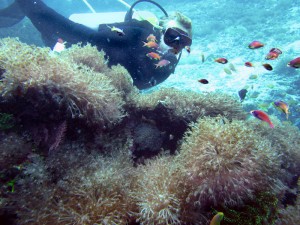
According to the Philippine Atmospheric, Geophysical and Astronomical Services Administration, the Philippines land area is slowly shrinking as the sea level continues to rise by one-point-eight millimeters every year. If this is true, most of the country will be underwater in less than 150 years.As we have seen already in the U.S., global warming affects everyone. Hopefully, through a universal effort, we’ll be able to curb its effects. For now, we’re able to enjoy fantastic reef life underwater and the absence of signal lights or honking horns topside. And there’s no light pollution at night, as well. I looked up and saw the Southern Cross shining bright.
There are Department of Tourism offices in Chicago, Los Angeles, New York and San Francisco. Visit ExperiencePhilippines or WowPhilippinesfor more information.Note: Pack as lightly as possible. Depending on the domestic carrier’s weight allowance (ten kilos for some), you can be charged heavily for both checked-in and carry-on bags.
About Denise Mattia
A writer and photographer, Denise Mattia’s works are published nationally and internationally and include all aspects of leisure travel: art , culture, resorts, spas, food and wine and sports’ activities. She's the founder of the soon to be launched Yum-Yum-Traveler, a site devoted to reviewing restaurants in addition to her travel articles from around the world. She lives and works in Manhattan, where she was born.
- Web |
- More Posts (91)
